5 homemade fertilisers that will make your garden grow
Here are five effective – but easy – homemade fertilisers for your garden from the organic Abbey Physic Community Garden in Faversham.
- Comfrey or nettle tea, made in a water butt
- Concentrated liquid garden fertiliser made from well-rotted farmyard manure
- Lasagna gardening – layered levels of cardboard, compost, leaf mould, grass clipppings or turf.
- DIY garden fertiliser made from upturned turf
- Leaf litter
The Abbey Physic Community Garden provides therapy and skills training in horticulture for people with isolated by mental or physical health issues, social or economic disadvantage as well as for the community in general.
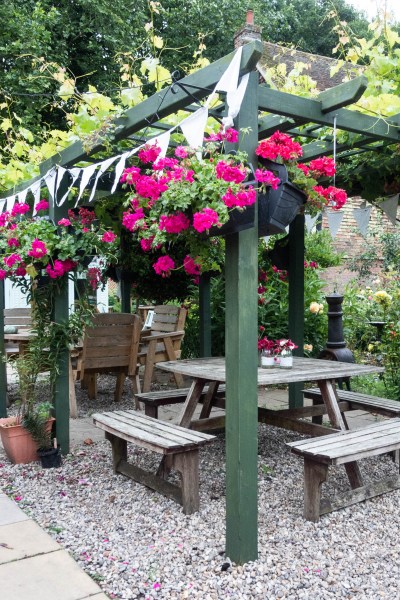
Outdoor seating at the Abbey Physic Community Garden’s Happy Cafe.
There is art and craft training, a Men’s Shed and a community kitchen plus the Happy Cafe, so that people can learn to cook what they grow.
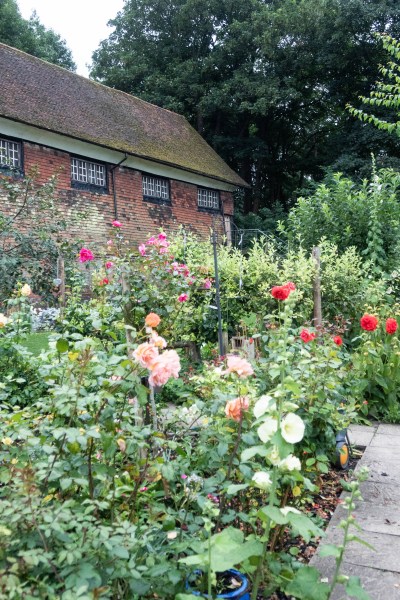
The Abbey Physic Garden is half an acre in the heart of Faversham, in the grounds of the Old Elizabethan Grammar School.
The half acre garden has been cultivated since the time of Henry VIII and Faversham Abbey and it is now an organic experimental garden. There is a hugelkultur bed, forest gardening, beehives and bug hotels, a pond and a glorious mix of productive vegetables and flowers, which attract pollinators.
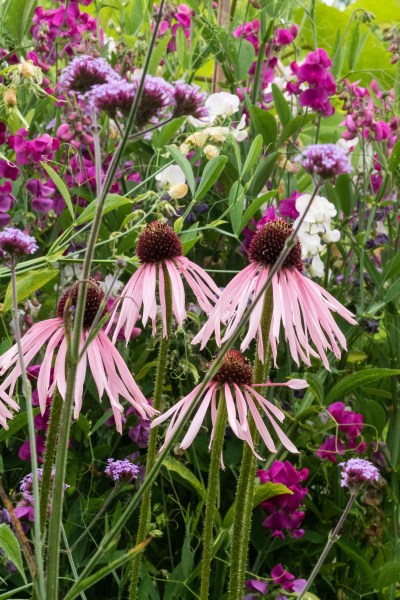
Flowers, fruit and veg grow side-by-side in the Abbey Physic Garden. This attracts pollinators to the fruit and veg, and looks beautiful.
The gardening is eco-friendly. And as eco-friendly is always about using resources carefully, that means it’s money-saving too. And with so many different people involved in a garden with volunteers, tips have to be easy to explain and carry out.
So I asked Paul Muddle, head gardener at the Abbey Physic for their tips for easy effective homemade fertilisers.
Homemade fertilisers made from comfrey or nettles
They grow comfrey for fertiliser at the Abbey Physic. It’s a very invasive plant, so you’re advised to use a variety called Bocking 14, which doesn’t spread. You can also make fertiliser tea with nettles. You can probably collect them from roadsides and common land in the summer.
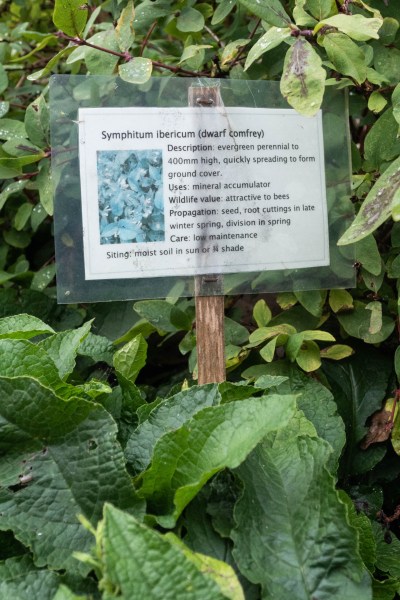
There are several types of comfrey grown at the Abbey Physic. This one, dwarf comfrey, may be a little too invasive for private gardens. But, on the other hand, it’s low maintenance and pollinators love it, so that could be a bonus for the time-poor gardener!
However, we don’t have a legal right to harvest nettles from someone else’s land, so it is best to ask first.
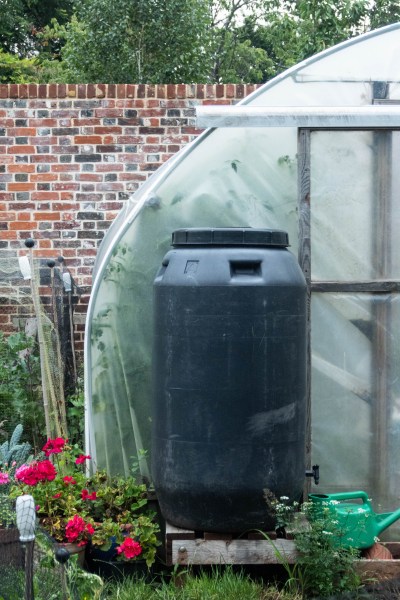
This water butt is used for comfrey or nettle tea and is positioned conveniently close to the polytunnel where the tomatoes are grown. In case you are wondering where the water comes from, water is siphoned into this butt from one of the water butts attached to the shed gutterings.
Take a bucket of nettle or comfrey leaves and throw it into a large water butt full of water. Let it sit there ‘until it stops stinking’, which will be about a month.
Paul says that the decomposing leaves can sometimes block the water butt tap. To prevent that, he suggests stuffing the comfrey or nettle leaves into a pair of tights, and then immersing the tight in the water. Then take out the tights, cut them open and put the soaked leaves on the compost heap.
The comfrey or nettle fertiliser should be about the colour of weak tea. If it looks stronger, dilute it to the ‘weak tea’ shade.
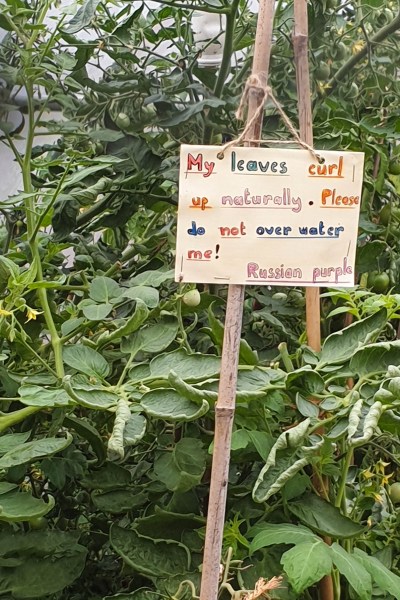
Tomato watering instructions in the polytunnel. With so many people involved in the garden, care instructions could get confusing unless they’re written down.
Pour it onto the soil around the plant, not the leaves. Use it to feed tomatoes weekly and ‘anything that looks a bit sad’ on a monthly basis.
Manure tea fertiliser
When you buy a stock of well rotted manure from local stables or a garden centre, add some of it to a bucket. Fill the bucket about two thirds full of manure and about one third with water.
Leave it for a week. Then pour off the liquid and dilute it in a proportion of approximately one part liquid manure to five parts water. Pour it around the roots of plants that need fertilising. The manure itself can go on beds or the compost heap.
Lasagna gardening
Lasagna gardening is a way of enriching your soil if you don’t have space for a compost heap. And it can be valuable even if you do.
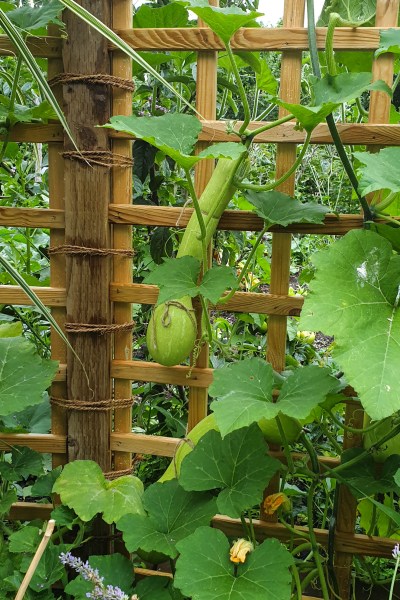
At the Abbey Physic Garden, ‘hungry’ plants, such as this trombocino squash, are given extra nutrition with a ‘lasagna’ garden around their roots.
Although it’s common to see an entire bed turned over to lasagna gardening, Paul uses the technique on individual plants, particularly ‘hungry’ ones like squash. (In the flower border, roses would count as ‘hungry plants’ too).
Lay upside down turf or grass clippings around the roots of the plant. Cover it with cardboard.
Finish by adding leaf litter and compost with the compost layer on top. This will all break down on the soil and will feed the plant. It’ll also help retain moisture in the soil during a dry summer. And it stifles annual weed seeds. Win, win all round!
You can also lay the lasagna on the ground before planting, and cut holes in the cardboard to plant.
‘It’s like a mini compost heap,’ says Paul. ‘And it’s particularly valuable if you have heavy clay soil or thin sandy soil. Just don’t add too many grass cuttings or it gets slimy.’
Upturned turf fertiliser heap
Upturned turf makes a great mulch. If you or a friend have leftover turf squares from a newly installed lawn, turn it upside down in a pile and let it rot down into a rich loam.
Leaf litter
I’ve always been somewhat frustrated by how long it takes dead leaves to decompose down into a proper leaf mould.
However, at the Abbey Physic they use leaves that aren’t fully composted down as one of their homemade fertilisers. Bag it all up, advises Paul. Keep it moist and leave it to sweat down. Don’t turn it.
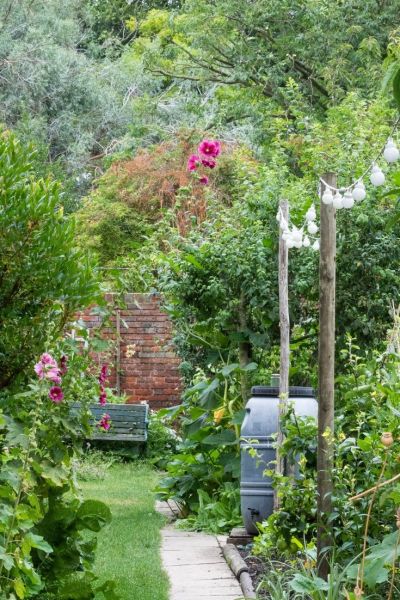
The Abbey Physic Community Garden is surrounded by tall trees. The leaves make valuable leaf litter.
Spread it on your borders the following spring. It doesn‘t have to rot down completely – I could still see non-decomposed leaves around the base of the roses at The Abbey Physic.
If you have leaves on your lawn, use the lawn mower to chop them up before bagging them.
More about the Abbey Physic Community Garden
You can find out more about what The Abbey Physic Community Garden does on their website. I also interviewed them on wildlife-friendly gardening – see What Makes a Good Wildlife Garden.
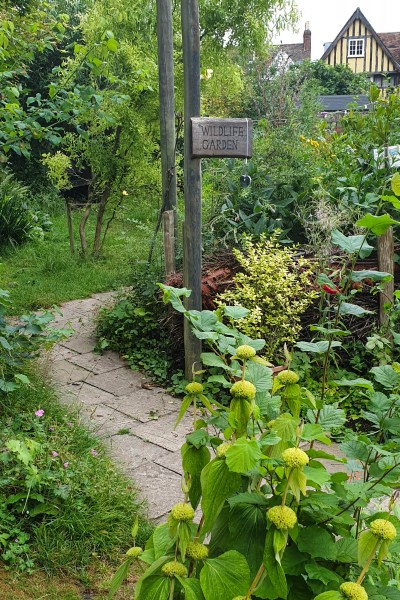
A wildlife-friendly organic garden in the middle of town.
And there’s a post on gardening in March, which shows the design of the Abbey Physic. As a square town garden, it has been beautifully divided up with a curving path through the centre.
Pin to remember recipes for homemade fertilisers
And discover more tips, ideas and inspiration for your garden by following the Middlesized Garden blog by email. Fill in the email follow box below and we’ll pop into your inbox very Sunday morning.

























When I was a child I remember my father putting a hessian sack of horse manure in the water butt he said it was the best feed for the vegetables and flowers but did have to be diluted
Sometimes the old ways are the best…